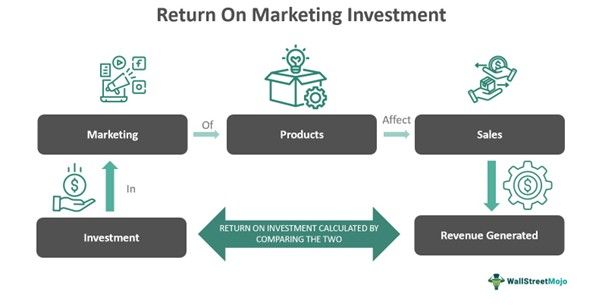Table of Contents
Return On Marketing Investment (ROMI) Definition
Return On Marketing Investment (ROMI) is the amount of revenue generated from the marketing efforts and campaigns that individuals or entities spend to boost sales. ROMI helps firms prepare the best marketing budgets, measure expenditure on advertising, and justify marketing campaigns. As a result, it also forms the benchmark of a firm's marketing campaign performance.

Return On Marketing Investment allows companies to assess how fruitful their investment in marketing campaigns and tools is turning out to be. In short, it becomes an indicator of the effectiveness of the campaigns. For a campaign to prove effective, however, the revenue must be more than one dollar for every dollar spent on marketing.
Key Takeaways
- Return on marketing investment (ROMI) is understood as a tool to measure the revenue generated with respect to the amount invested in marketing activities for a product.
- It gets calculated using the formula Return On Marketing Investment (ROMI) = (total sales revenue – marketing expenditure)/ marketing expenditure * 100
- Its primary goals are to create effective marketing budgets, track advertising spending, and defend marketing efforts. It also serves as a gauge of how well a company's marketing campaign is performing.
- Using ROMI in marketing tools has various advantages, including measuring the extent to which marketing initiatives create income relative to the dollar amount spent on them while aiding in budgetary balance.
ROMI Explained
Return on marketing investment (ROMI) has been used by marketers as a key metric to assess the overall efficiency of their marketing campaigns so that they can make better decisions on allocating investments accordingly in the future. Most digital marketers try to increase the efficiency of their future campaigns and measure intangible benefits by including brand awareness within the metrics of their ROMI. The major components in determining the ROMI for any marketing campaign are incremental sales measurement and its eventual estimation.
When the ROMI is figured out, the firms understand how much to spend on the campaigns for better returns. Once the methods they experiment with seem to work, the organizations do not hesitate to spend more time on it. On the other hand, if the results fail to show efficacy, the companies know where to stop experimenting further. Hence, measuring and managing return on marketing investment becomes a key indicator of assessing the fruitfulness of the marketing tricks an entity uses.
Moreover, there are two types of effectiveness that ROMI helps assess – short-term and long-term. The short-term effectiveness lets companies figure out the immediate effects of the marketing campaigns on the sales figures. The immediate effects allow companies to adjust marketing efforts accordingly based on the nature of the results generated. For example, if the results are positive, they stick to the same efforts, or they switch to some other approach. On the other hand, the long-term effectiveness is measured to find out how efficient the marketing investment would prove to be in the long run.
Formula
The equation below shows how to calculate the return on marketing investment (ROMI):
Return On Marketing Investment (ROMI) = (Total Sales Revenue – Marketing Expenditure)/ Marketing Expenditure * 100
Calculation Example
Suppose a company, ABC Organics, wants to know about the ROMI from the marketing campaign. They have been running a 20,000-dollar campaign for the last seven months. At the end of the campaign, they analyzed the sales growth, which accounted for 30,000 dollars. To get the exact percentage of return on the investments made in marketing, the effecting result of the marketing campaign will be calculated using the formula:
Return On Marketing Investment (ROMI) = (Total Sales Revenue – Marketing Expenditure)/ Marketing Expenditure * 100
From the data given for ABC Organics, one gets the following:
Total Sales Revenue = $30,000
Marketing Expenditure = $20,000
therefore, ROMI = 30000-20000/20000*100= 50%
Thus, it clearly states that the marketing campaign has increased the company's sales by fifty percent.
Importance
The return on marketing investment definition remains incomplete until the significance of the concept is explored. Let us check out some of the benefits of calculating ROMI:
- Easy assessment of the projected and historical marketing productivity
- Easier approvals and reviews of marketing budgets
- Enables limiting marketing funds within marketing mix items, competing brands, markets, media, and products.
- Helps evaluate particular marketing campaigns to decide whether or not to go or its campaigns
- One can measure the extent to which marketing campaigns generate revenue for the amount of money spent on it
- Able to note the marketing success in numerals
- Helps in making decisions driven by data
- Allows balancing the marketing budget.
- Marketing strategy gets streamlined
- Analysis of competitors get started
- A creative department can be made accountable
- A team focused on future development gets built
- The accuracy of the forecasting is improved
- New technologies get introduced
- Management remains happy with the outcome
- Pushes everyone to follow the same goal
